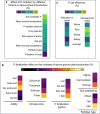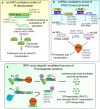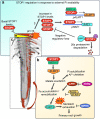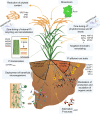Prospects of genetics and breeding for low-phosphate tolerance: an integrated approach from soil to cell
- PMID: 35524816
- PMCID: PMC9729153
- DOI: 10.1007/s00122-022-04095-y
Prospects of genetics and breeding for low-phosphate tolerance: an integrated approach from soil to cell
Abstract
Improving phosphorus (P) crop nutrition has emerged as a key factor toward achieving a more resilient and sustainable agriculture. P is an essential nutrient for plant development and reproduction, and phosphate (Pi)-based fertilizers represent one of the pillars that sustain food production systems. To meet the global food demand, the challenge for modern agriculture is to increase food production and improve food quality in a sustainable way by significantly optimizing Pi fertilizer use efficiency. The development of genetically improved crops with higher Pi uptake and Pi-use efficiency and higher adaptability to environments with low-Pi availability will play a crucial role toward this end. In this review, we summarize the current understanding of Pi nutrition and the regulation of Pi-starvation responses in plants, and provide new perspectives on how to harness the ample repertoire of genetic mechanisms behind these adaptive responses for crop improvement. We discuss on the potential of implementing more integrative, versatile, and effective strategies by incorporating systems biology approaches and tools such as genome editing and synthetic biology. These strategies will be invaluable for producing high-yielding crops that require reduced Pi fertilizer inputs and to develop a more sustainable global agriculture.
© 2022. The Author(s).
Conflict of interest statement
The authors declare they have no financial interests.
Figures






Similar articles
-
Phosphate nutrition: improving low-phosphate tolerance in crops.Annu Rev Plant Biol. 2014;65:95-123. doi: 10.1146/annurev-arplant-050213-035949. Epub 2014 Feb 24. Annu Rev Plant Biol. 2014. PMID: 24579991 Review.
-
Plant resilience to phosphate limitation: current knowledge and future challenges.Crit Rev Biotechnol. 2021 Feb;41(1):63-71. doi: 10.1080/07388551.2020.1825321. Epub 2020 Oct 7. Crit Rev Biotechnol. 2021. PMID: 33028118 Review.
-
Prospects for Using Phosphate-Solubilizing Microorganisms as Natural Fertilizers in Agriculture.Plants (Basel). 2022 Aug 15;11(16):2119. doi: 10.3390/plants11162119. Plants (Basel). 2022. PMID: 36015422 Free PMC article. Review.
-
Progress in Microbial Fertilizer Regulation of Crop Growth and Soil Remediation Research.Plants (Basel). 2024 Jan 24;13(3):346. doi: 10.3390/plants13030346. Plants (Basel). 2024. PMID: 38337881 Free PMC article. Review.
-
Enhancement of Plant Productivity in the Post-Genomics Era.Curr Genomics. 2016 Aug;17(4):295-6. doi: 10.2174/138920291704160607182507. Curr Genomics. 2016. PMID: 27499678 Free PMC article.
Cited by
-
Improving phosphorus acquisition efficiency through modification of root growth responses to phosphate starvation in legumes.Front Plant Sci. 2023 Feb 10;14:1094157. doi: 10.3389/fpls.2023.1094157. eCollection 2023. Front Plant Sci. 2023. PMID: 36844096 Free PMC article. Review.
-
Beneficial Effects of Phosphite in Arabidopsis thaliana Mediated by Activation of ABA, SA, and JA Biosynthesis and Signaling Pathways.Plants (Basel). 2024 Jul 6;13(13):1873. doi: 10.3390/plants13131873. Plants (Basel). 2024. PMID: 38999712 Free PMC article.
-
Recent advances in research on phosphate starvation signaling in plants.J Plant Res. 2024 May;137(3):315-330. doi: 10.1007/s10265-024-01545-0. Epub 2024 Apr 26. J Plant Res. 2024. PMID: 38668956 Free PMC article. Review.
-
The recent genetic modification techniques for improve soil conservation, nutrient uptake and utilization.GM Crops Food. 2024 Dec 31;15(1):233-247. doi: 10.1080/21645698.2024.2377408. Epub 2024 Jul 15. GM Crops Food. 2024. PMID: 39008437 Free PMC article. Review.
-
Molecular signatures that translate across omics layers and crops under high aluminium and low phosphorus stress facilitate the identification of reliable molecular targets for genotyping in lentil.Funct Integr Genomics. 2025 Mar 5;25(1):52. doi: 10.1007/s10142-025-01542-z. Funct Integr Genomics. 2025. PMID: 40042647
References
Publication types
MeSH terms
Substances
Grants and funding
LinkOut - more resources
Full Text Sources
Research Materials
Miscellaneous

